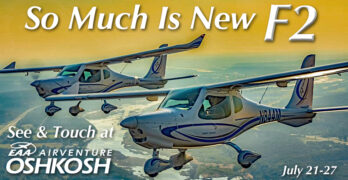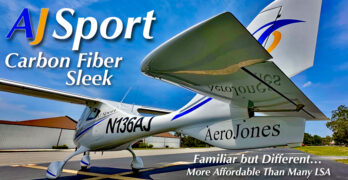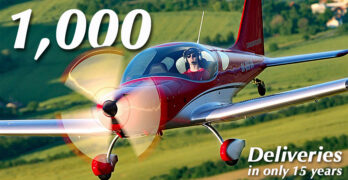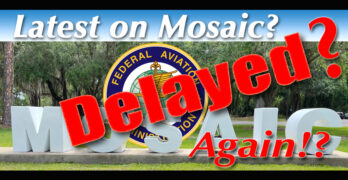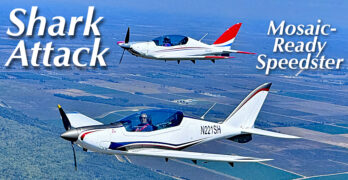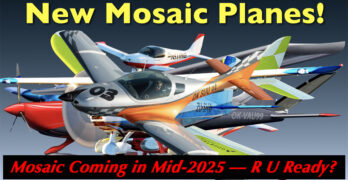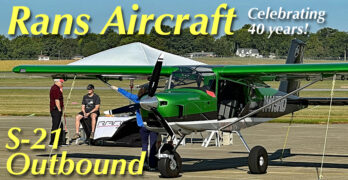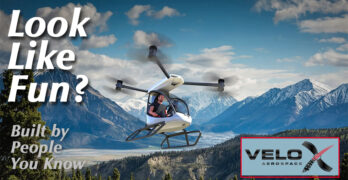Since Light-Sport Aircraft first arrived on the aviation scene back in 2004, one brand has lead the fleet as it grew impressively. Flight Design has manufactured nearly 2,000 aircraft over those 21 years. Its several models can be found in most countries on Earth.
After producing hundreds of CT-series LSA, the German company introduced their all-new F2 model with FAA’s still-to-come Mosaic regulation in mind. In every way, F2 is a premium upgrade to their earlier model. Numerous pilots have placed deposits.
Imagine the challenge. Before Russia invaded, the Germany company did most of their fabrication in Ukraine. As hostilities increased, the company relocated staff, tooling, and inventory to the Czech Republic. Similar to most airframe builders, many components are sourced from countries best at manufacturing those parts.
So Flight Design is already — has long been — an international company with operations in several nations. That it has new Chinese ownerships speaks significantly to businessmen in that country having the funds needed.
New “Made-in-USA” Aircraft — Welcome AJ Sport to the LSA Fleet
Is it because of tariffs? Another reason? Or simply a good idea? Does it matter why you’re reading about AJ Sport?
U.S. government policies swing and sway the world in remarkable ways. That’s a whole story in itself, but the way aircraft suppliers respond to the situation they are facing can be instructive.
To be clear, AeroJones Aviation is not reacting to tariff changes. This company, headquartered in U.S.-friendly Taiwan, has been working toward entering the American market for years. For more than a decade, AeroJones has been the officially-licensed producer of Flight Design’s CTLS and CTLSi for Asia-Pacific. They don’t simply import and sell units built in Europe. They do 100% of the fabrication, assembly, and production test flights in the Asian theater. They’ve delivered more than 50 aircraft and have won multiple CAAC airworthiness approvals.
A video to follow soon features SilverLight Aviation‘s Abid Farooqui describing several notable changes the company achieved.
Why Beringer? — 40 Years, Premium Hardware, Tariffs, and Expanding in America
You’ve seen them with their distinctive bright colors and finely-finished hardware. Almost every pilot has. First, they took a big share of the LSA and Sport Pilot kit market. Then they expanded into GA aircraft. Now, welcome a whole new concept for Beringer Aero USA.
This story is not simply about a popular French aviation brand selling products in America.
Now, they are opening a U.S. production facility — and you could be part of it!
After steadily building loyal Yankee customers Beringer knows the USA is a major market. They also understand Americans like buying from USA companies.
In 2025, we add the wrinkle of Tariff Wars, making a long-term plan look truly inspired.
Colorful Future
“Beringer Aero USA is excited to share multiple updates about our company’s remarkable journey and recent developments,” wrote Beringer CEO Claire Beringer.
Claire also noted 2025 marks her company’s 40th anniversary.
What Do AOPA, EAA, and LAMA Have In Common? …MOSAIC!
Well before Sun ‘n Fun 2025, a remarkable thing happened. The large and small of aviation got together to request the administration grant special handling for aircraft in the Tariff Wars.
Giants like GAMA, the General Aviation Manufacturers Association and small organizations like LAMA, the Light Aircraft Manufacturers Association joined forces to make the tariff exemption request. Wish them luck! You may benefit.
If you think a GAMA/LAMA joint initiative is an unusual request, you may have missed that aircraft and aircraft parts are often exempted from these sorts of political power plays. The whole world recognizes the value of aviation. Yet compared to cars, computers, steel, or oil, aircraft and aircraft parts represent a modest percentage of the global marketplace. Since it is important yet relatively small, it has frequently received special handling.
At Sun ‘n Fun a remarkable thing repeated. Again, leaders got together, but this time it was to discuss and explain Mosaic.
Bristell LSA-Maker BRM Aero Reaches #1,000 Milestone
In the airplane-manufacturing enterprise, very few companies have exceeded four figures of aircraft deliveries. The newest producer to achieve this feat did so in only 15 years.
BRM Aero announced, “Last year (2024) was a remarkable year for Bristell Aircraft. Reaching our 1,000th aircraft milestone, securing vital certifications, and maintaining strong production numbers have demonstrated our commitment to excellence in aviation.”
I wrote about BRM hitting 300 deliveries in 2017 (eight years after starting up). Now, seven years later BRM has reached their 1,000th aircraft delivered. That’s a second half average of 100 units per year, a production rate any company would be proud to have — even for businesses operating many more years. In 2024 alone, 112 Bristell models were delivered showing the current pace the Czech company is achieving.
Part of the reason for this success is a surprising diversity of aircraft models based on the original.
Mosaic! …Or No Mosaic (Yet)? — That Is the Question
OK, so we have a new U.S. President and Trump often promised to “Eliminate 10 new rules for every new one proposed.”
On the campaign trail, this was only promises, such as every politician makes. Now comes reality. Will our new president do what he said?
Regular readers will recognize Roy Beisswenger. Roy and I made several trips to Washington, DC in an attempt by LAMA, the Light Aircraft Manufacturers Association, to encourage FAA to make changes to the then-10-year-old Sport Pilot / Light-Sport Aircraft regulation. Our work, starting in 2014, began a few years before anyone knew anything about Mosaic. Being involved for ten years provided lots of knowledge about FAA rule making, leading to actions later known as Mosaic.
In his day job, Roy is the proprietor of Easy Flight, the nation’s premiere powered parachute educator and flight trainer. Follow the link to learn more.
Shark Attack — Review and Video of a Striking Mosaic-Ready Aircraft
Readers who scour the Internet looking for fascinating Light-Sport Aircraft may already know Shark. Conceived by Jaro Dostal in the Czech Republic, this design is the latest from a man who has a long, storied history of aircraft for the light aviation set.
Jaro’s work included the Skyboy from the early days of LSA and later the MD-3 SportRider. Both won approval from many pilots.
All Jaro’s designs have one common easily-seen design characteristic: his shark fin vertical tail. Of course, this one is no different in that respect but it is the first to openly embrace the name. With this speedy aircraft already flying in North America and with more on the way, I couldn’t resist the compelling “Shark Attack” title. Let’s check it out.
Shark.Aero
Shark is built at a factory in the country of Slovakia in a region said to be well known for producing innovative designs.
Year-End Review of Changes Expected with FAA’s Mosaic Rule — in Mid-2025
Let me do the obvious first. Mosaic has for some weeks been in what agency personnel call their “quiet period.” This is when FAA is finalizing a regulation and will no longer respond to info requests. Public comment windows are long closed.
Short take — We know only a little more than we did a few months back. Major questions remain about what license level of pilot can fly what configuration of Mosaic LSA using what medical. We have no new information on these questions. In addition, many in the LSR-M mechanic community also have many questions and concerns.
The public had a chance to comment, and lots of you did. Now, after reading every single comment, FAA rule writers are head down preparing the final version
Coming in Mid-205
Word from those who talk to FAA about other matters say the Mosaic reg is proceeding well. It is expected by “mid-2025,” though such pronouncements have often proved premature.
American Aviation Superhero — RANS and Load-Carrying S-21 Outbound Are Mosaic-Ready
What great to see? How about an American light aircraft producer doing exceptionally well? RANS has been around 50 years*, 40 of them as an aircraft developer and producer. From S-3 to S-21, the designs have varied but the newest is Outbound and it adds capabilities and structure to set it apart from all prior models.
Over the years this Kansas company in the geographical center of the USA has delivered around 7,000 aircraft making it one of the light aircraft success stories of all time. Lead by founder Randy Schlitter, the manufacturer has become a leading aviation brand known and flown around the world.
In the video interview below, Randy’s wife Michele Schlitter walks us through the years and highlights the pinnacle of their achievement, a tricycle-gear, tundra-tired, all-metal creation that can carry 800 pounds, Michele said in the video.
You can build it or they can build it. A kit is available faster for obvious reasons.
A Multicopter Current Pilots Might Enjoy? …Developed Within Our LSA Industry
Here’s a helicopter-like aircraft you might actually consider. I have often reviewed what I call multicopters (several articles). I searched for aircraft you might fly for fun; several of them can enjoy the freedom and special benefits of Part 103. I’ve stayed away from commercial “air taxi” projects.
But what if a longtime producer of Light-Sport Aircraft entered the space? What if the aircraft looked like a helicopter but one you could fly without the steep learning curve? What if it offered 45 minutes of flight with a 15-minute reserve?
The earliest entries had short flight times, 15-20 minutes. Most of them cost too much. For example, Opener’s Blackfly (now called Helix) was first promoted at the cost of a “luxury SUV,” perhaps meaning $80,000 at the time. It has since more than doubled in price.
You may doubt or dislike these flying machines, especially when you don’t know the people behind the projects.


